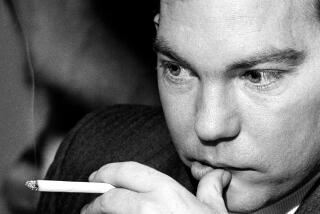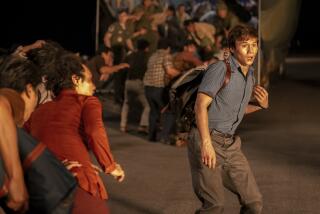Witnesses to Pol Pot’s terror
A few days before Saigon was overrun by the North Vietnamese in April 1975, Cambodia’s capital, Phnom Penh, fell to the Khmer Rouge, Cambodia’s indigenous Communist forces led by Pol Pot. During the next 3 1/2 years, more than 1.5 million Cambodians -- about 20% of the population -- were executed or died of starvation or disease as a result of the policies of Pol Pot and his associates. Khmer Rouge crimes, widely labeled as genocide, have earned Pol Pot a place alongside Hitler, Stalin and Mao as one of the great mass murderers of the 20th century.
Philip Short, a former correspondent for the BBC and author of “Mao: A Life,” spent several years traveling around Cambodia, interviewing all who would talk to him for “Pol Pot: Anatomy of a Nightmare.” Drawing from interviews and documents from Cambodia, China, France, Russia and Vietnam, Short provides rich detail on the minutiae of Cambodian politics. Regrettably, his prodigious research and the flood of his narrative overwhelm Short’s portrait of Pol Pot and his effort to explain how the Communist party leader became such a monster.
Saloth Sar, Pol Pot’s real name, was born in 1925 to a prosperous landowner at a time when Cambodia was part of French Indochina. Short describes him as a mediocre student who nonetheless performed well enough at a technical school to win a scholarship to study engineering in Paris in 1949. People who knew him before he left Cambodia remembered him as warm and friendly, athletic, fond of music and poetry, with an engaging smile. No one noted any characteristics or beliefs that might portend the role he would play in the 1970s.
It was in Paris that he read of the French Revolution and was introduced to the writings of Karl Marx. He and his Cambodian comrades became Communists, initially joining the French Communist Party. Short, however, contends that Marxist-Leninism did not determine Pol Pot’s course, but rather that Cambodia’s native Khmer culture and Buddhism did.
Short offers a harsh view of Khmer culture, which he argues has contempt for qualities such as loyalty and frankness, perceives forgiveness as weakness and does not consider the possibility that people can be reformed. The author regards as culturally determined Pol Pot’s deceptions, his purges of comrades, his inability to conceive of national reconciliation with his erstwhile opponents and his orders to kill prisoners. Gen. Lon Nol, whose U.S.-backed government was overthrown by the Khmer Rouge, and Prince Norodom Sihanouk, the sometime-monarch and perennial contender for power in Cambodia, were, according to Short, guilty of comparable misdeeds -- although of a lesser magnitude.
Pol Pot’s hatred of the Vietnamese and the anti-Vietnamese pogroms he ordered may reasonably be attributed to Khmer culture and the historic enmity of the Vietnamese and Khmer peoples. But even granting that possibility, surely his admiration for Stalin, Mao and North Korean dictator Kim Il Sung contributed at least as much to his choice of policies and the means he chose to implement them.
Short is also on shaky ground when he points to Pol Pot’s Buddhist education as the source of some of his programs. Buddhism may indeed call upon believers to suppress their individuality and urge them not to value wealth, but Buddhism does not direct its followers to kill those who do not live by its tenets. Nor, as he contends, are its followers more attracted to extremes than those who live in Confucian societies -- or any other.
Pol Pot returned to Cambodia in 1953 as Vietnamese nationalist forces fought to liberate Indochina from French rule -- and bring it under Vietnamese control. Joining the resistance, he shared the desire to drive out the French, but he was equally determined to fight for a Cambodia free of Vietnamese influence. From 1953 to 1970, however, it was Sihanouk who negotiated an independence agreement with France, walked a tight-wire between the Vietnamese and the Americans, and struggled to maintain a semblance of neutrality without the strength to confront either as America’s war in Vietnam heated up in the 1960s.
Then in March 1970, Sihanouk’s government was overthrown in a coup led by Lon Nol, whose expectation of American support proved justified. The U.S. military and its South Vietnamese clients had been eager to strike at North Vietnamese sanctuaries in Cambodia. Sihanouk had held them off. Lon Nol did not. The American and South Vietnamese attacks on the North Vietnamese in Cambodia triggered a brutal civil war in which Lon Nol’s forces were supported by Washington and the Khmer Rouge were backed by Hanoi. In the first year of that contest, North Vietnamese troops did most of the fighting and U.S. warplanes dropped enormous quantities of bombs on the Cambodian countryside.
In 1972, the Khmer Rouge stepped up their military effort and by 1975 took the lead in the defeat of government forces. No sooner had they taken Phnom Penh than they began to evacuate the city and the country’s other urban areas. All city residents, even hospital patients, were sent on forced marches during which thousands died. Pol Pot and his comrades were determined to relocate the population as a means of creating a Cambodian utopia of self-sufficient peasant collectives, a model society for the rest of the world. In fact, they created what Short calls a “slave state” in which hundreds of thousands of people starved and hundreds of thousands more, who were perceived as obstacles to revolutionary change, were tortured and murdered. Hundreds of thousands of Vietnamese living in Cambodia were driven out or killed.
Pol Pot’s hatred of the Vietnamese was ultimately his undoing. Determined to preclude Vietnamese influence in Cambodia, he launched a series of provocative attacks across the border in Vietnam in 1978. In December, Vietnam launched a counteroffensive, and within a month, the Khmer Rouge had collapsed and Vietnamese forces took Phnom Penh. There, they installed a government dominated by Cambodians, including Khmer Rouge rebels who had fought under Vietnamese direction against Lon Nol and Pol Pot’s forces. Pol Pot and his loyal supporters were reduced to fighting a guerrilla war for their survival -- and might soon have vanished but for the vagaries of international politics.
To the murderous Pol Pot’s rescue came the United States and China, united in a tacit alliance against the Soviet Union, which was supportive of Vietnam. Putting pressure on Vietnam presumably weakened the Soviets, and for the duration of the Cold War, the United States provided aid to keep the Khmer Rouge in the field. By 1984, the Vietnamese were pulling back, but the government they’d installed in Phnom Penh proved remarkably resilient. When the Cold War ended in 1989, the United States extricated itself from involvement with the most odious of its erstwhile allies, dooming the Khmer Rouge.
However, Pol Pot continued his fight, described by Short as a “mosaic of idealism and butchery,” until he was captured by government forces in April 1997 and placed under house arrest. He died in his bed in April 1998, never forced to explain or apologize for the horrors he inflicted on his people, never punished for his extraordinary crimes. But then, several of his former associates, complicit in his actions, were high-ranking members of the new regime. *
More to Read
Sign up for Essential California
The most important California stories and recommendations in your inbox every morning.
You may occasionally receive promotional content from the Los Angeles Times.










